


 |
 |
 |
At 0100 hours Zulu CIA A-12 pilot Frank Murray departed Kadena on a routine overflight of North Vietnam. Mission BX 6726 had been canceled and Frank's mission called to  fly the previously canceled mission. As he completed his first pass over denied territory Murray heard a loud bumping sound and noticed fluctuation in the oil pressure gauge for his right engine. The oil pressure of Article 131's right engine dropped to zero at he approached 20 miles to INS position 06.
fly the previously canceled mission. As he completed his first pass over denied territory Murray heard a loud bumping sound and noticed fluctuation in the oil pressure gauge for his right engine. The oil pressure of Article 131's right engine dropped to zero at he approached 20 miles to INS position 06.
After shutting down the right engine, Murray kept the good engine at max thrust until clear of North Vietnam airspace, and then started his descent on the path to the intended tanker. While over Laos Murray called the tanker on the secure radio, telling the tanker crew that he was aborting the rest of the mission and planned to land at Takhli AB in Thailand. Unknown to Murray, Takhli AB was the home of a CIA U-2 detachment. The tanker relayed what he knew back home, however the abort was well underway by now. When Murray arrived overhead at Takhli, he tried to contact the control tower without success. It was then that the tanker reminded him he was still transmitting in the secure radio mode. This explained why the tower wasn't answering. After switching to the normal UHF mode, the tower was told that an emergency recovery was going to happen soon. The tower wanted to know what type airplane was involved, how many souls on board, how much fuel on board etc. The usual things a control tower asks. Murray told the tower the airplane type was classified and that he had one soul on board and the fuel state was about 15,000 lbs. About this time the tower was asking if the emergency aircraft could hold while the base launched a large strike force.
 Murray told the tower that he was twenty miles out on a straight-in approach. All the while the base was not visible to Murray due to cloud cover over the base. At about five miles and under the cloud deck Murray sighted the runway and prepared for a single engine landing (which for him was not really a great problem). With the gear down, the tower could now see what must have been quite a sight, an A-12 approaching the base. The landing was uneventful, but as Murray cleared the runway on a taxiway, he informed the tower that the runway was fouled by the small chute that deploys the main drag-chute and a good number of rubber bands from the deployed drag-chute. This unscheduled emergency landing caused a considerable delay in the launch of a large F-105 strike force bound for North Vietnam. Murray's tanker landed also as he had the PF-1 fuel needed to service the A-12 for the recovery to Kadena.
Murray told the tower that he was twenty miles out on a straight-in approach. All the while the base was not visible to Murray due to cloud cover over the base. At about five miles and under the cloud deck Murray sighted the runway and prepared for a single engine landing (which for him was not really a great problem). With the gear down, the tower could now see what must have been quite a sight, an A-12 approaching the base. The landing was uneventful, but as Murray cleared the runway on a taxiway, he informed the tower that the runway was fouled by the small chute that deploys the main drag-chute and a good number of rubber bands from the deployed drag-chute. This unscheduled emergency landing caused a considerable delay in the launch of a large F-105 strike force bound for North Vietnam. Murray's tanker landed also as he had the PF-1 fuel needed to service the A-12 for the recovery to Kadena.
After stopping on the taxiway, Murray called for the base commander to discuss what to do and where to put the A-12. The first officer to come out to the A-12  was the Thai base commander. With that, Murray told the tower to have the American commander come out. He did arrive shortly after and they discussed where to move the A-12. The good engine was still running, so the airplane could be moved under its own power. They decided that the best place at the moment was the compass rose parking stand off the main taxiway.
was the Thai base commander. With that, Murray told the tower to have the American commander come out. He did arrive shortly after and they discussed where to move the A-12. The good engine was still running, so the airplane could be moved under its own power. They decided that the best place at the moment was the compass rose parking stand off the main taxiway.
It was there that Murray gave the American officer his letter of introduction. Shortly after that a group of people approached the A-12 and identified themselves as CIA people from the U-2 detachment. Now having knowledgeable assistance, Murray could shut down the engine providing air conditioning to his flight suit. The U-2 guys indicated that they would try to move the A-12 to their hangar as there were no other hangars on the base, only nose docks. They transported Murray to the U-2 compound to remove the pressure suit and make a call to Kadena describing the airplane problems.
Between the U-2 guys and the base, they concocted a tow bar to use in moving the A-12 to the 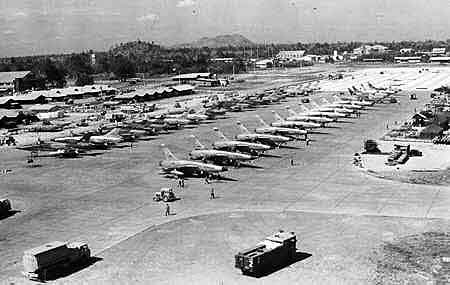 U-2 hangar. The pathway to the hangar was designed for the U-2 so it consisted of a single narrow hard surface which the A-12 nose wheel could ride upon. The main gear would be off the hard surface. They planned to position PSP planking for the main gear to ride on. Murray was in the cockpit while the towing operation took place. As the A-12 wheels rolled over the PSP it was destroyed by the weight of the airplane, but they had plenty of PSP so they continued on to the hangar. The U-2 hangar was sufficiently wide to house the A-12 but it was marginally suited in height. As the A-12 was approaching the hangar it became clear that the rudders were going to strike the top of the hangar doorway. After much discussion as how to proceed, they decided to deflate the main gear struts to gain clearance for the rudders. This action worked and the A-12 was now securely in the hangar with the doors shut to prevent prying eyes from watching what went on. The U-2 detachment people were able to download the camera and remove the film (take) for processing. Murray borrowed a flying suit from the U-2 guys and awaited the recovery team.
U-2 hangar. The pathway to the hangar was designed for the U-2 so it consisted of a single narrow hard surface which the A-12 nose wheel could ride upon. The main gear would be off the hard surface. They planned to position PSP planking for the main gear to ride on. Murray was in the cockpit while the towing operation took place. As the A-12 wheels rolled over the PSP it was destroyed by the weight of the airplane, but they had plenty of PSP so they continued on to the hangar. The U-2 hangar was sufficiently wide to house the A-12 but it was marginally suited in height. As the A-12 was approaching the hangar it became clear that the rudders were going to strike the top of the hangar doorway. After much discussion as how to proceed, they decided to deflate the main gear struts to gain clearance for the rudders. This action worked and the A-12 was now securely in the hangar with the doors shut to prevent prying eyes from watching what went on. The U-2 detachment people were able to download the camera and remove the film (take) for processing. Murray borrowed a flying suit from the U-2 guys and awaited the recovery team.
At the first indication of an abort, extending from Kadena Air Base to CIA Headquarters at McLean, a mad scramble had erupted to get Murray to safety and to protect the integrity of the mission. Protecting the secrecy of the A-12 was a prime concern. Call signs had been compromised by an unknown station, so new call signs had to be assigned for A-12 buddy recovery by Detachment 4 commo. A recovery team of 9 officers, 8 enlisted, 33 civilian, and 4000 lbs equipment were loaded on a KC-135 to join up with Murray and the plane. A C-130 with 24,800 lbs equipment and 2 civilians followed. The trip took 4 hours 11 minutes.
Unable to repair the broken link to oil pressure sensor, a wire was run through a panel door to provide operational oil pressure information. The improvised repair restricted the flight to low speed, which created all sorts of problems as a low and slow flight home to Kadena would expose the Oxcart vehicle to unauthorized viewing and to rapidly deteriorating weather conditions.
After the repairs were completed in the U-2 hangar, the A-12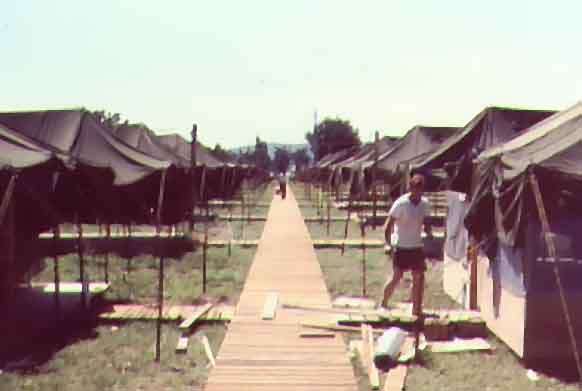 was moved outdoors back to the compass rose parking stand. The weak taxiway became a problem as it wasn't strong enough for the plane to return to the hangar once it was loaded with fuel. In the event of a delayed takeoff, the plane would have to be covered with tarps after servicing.
was moved outdoors back to the compass rose parking stand. The weak taxiway became a problem as it wasn't strong enough for the plane to return to the hangar once it was loaded with fuel. In the event of a delayed takeoff, the plane would have to be covered with tarps after servicing.
The ground crew did an engine start to check on their work. All went well so the plan was started for the flight to Kadena. Part of the preparation was the alignment and loading of the INS route to home base. The INS crew did not have a good bench mark position to load (present position) so they used the position of the Takhli AB base-ops furnished by the base.
Normally the A-12 would have been ground run on a tie down prior to release for flight, but there was no tie down good enough for the A-12 so it was decided that Murray would test the engine on takeoff.
Two SAC 903rd KC-135s were on station to organize a return buddy flight. Complicating matters, the recovery equipment brought up in C-130 was too large to fit in a KC-135 for return to Kadena.
Departure of the buddy flight required coordination with the area combat support commander to schedule departure during period of least observance and between takeoff of combat craft and their return. The return flight would have to avoid high traffic density and minimize opportunity for other aircraft to observe the Oxcart vehicle in flight. Heavy cirrus, ice and CB activity on both return routes became a factor. The Article would travel within a cell with a KC-135 carrying the PF-1 fuel. Article 131 would carry enough to make an emergency landing in South Vietnam if in dire need. Article 131 was to be identified as a KC-135 on buddy flight. F-105's from Takhli would escort the cell to a point near Saigon where F-4's would took up the escort mission to a safe point off-shore S. Vietnam.
There was no need for a pressure suit on the low altitude return flight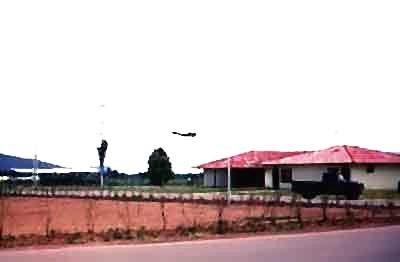 so Murray used a summer flying suit and his regular flying helmet that the recovery crew had brought from Kadena. One can only imagine the people gawking as Murray, his KC-135, and F-105 escorts took the runway for departure. Everybody on the base knew there was a Blackbird there and when the commotion started with the Buicks running they lined the taxiways. After liftoff of the buddy flight, the Agency security people went crazy trying to round up the cameras on base.
so Murray used a summer flying suit and his regular flying helmet that the recovery crew had brought from Kadena. One can only imagine the people gawking as Murray, his KC-135, and F-105 escorts took the runway for departure. Everybody on the base knew there was a Blackbird there and when the commotion started with the Buicks running they lined the taxiways. After liftoff of the buddy flight, the Agency security people went crazy trying to round up the cameras on base.
As the weather worsened, it had been decided that the KC-135 would be the buddy flight leader so it could use its radar to vector the flight around the weather cells. Sometimes on the flight back the tanker would lead and other times Murray led the flight. They had to not only avoid the storms, but a B-52 Arc Lite flight in Philippine air space as well. The return required three aerial refuelings of Murray's A-12. The return flight was made at 30,000 feet. The INS worked well and was not updated on the return. When Murray landed back at Kadena the INS was within spec for position and ground speed. Not bad after the crude start made hours before at Takhli. Murray had flown at Mach 3.19 and 81,000 feet for a duration of 2:20 hours prior to aborting. Imagery quality was good. His buddy flight back to Kadena lasted over 5 hours. The recovery and the experiences learned became procedure and part of the TAC doctrine. The CIA's wandering boy returned with a sore butt and credit for half a mission.
Sometimes on the flight back the tanker would lead and other times Murray led the flight. They had to not only avoid the storms, but a B-52 Arc Lite flight in Philippine air space as well. The return required three aerial refuelings of Murray's A-12. The return flight was made at 30,000 feet. The INS worked well and was not updated on the return. When Murray landed back at Kadena the INS was within spec for position and ground speed. Not bad after the crude start made hours before at Takhli. Murray had flown at Mach 3.19 and 81,000 feet for a duration of 2:20 hours prior to aborting. Imagery quality was good. His buddy flight back to Kadena lasted over 5 hours. The recovery and the experiences learned became procedure and part of the TAC doctrine. The CIA's wandering boy returned with a sore butt and credit for half a mission.
Stemming from this event was a couple of interesting side stories of things that happened along the way....
The first is something that occurred after a couple days of Murray 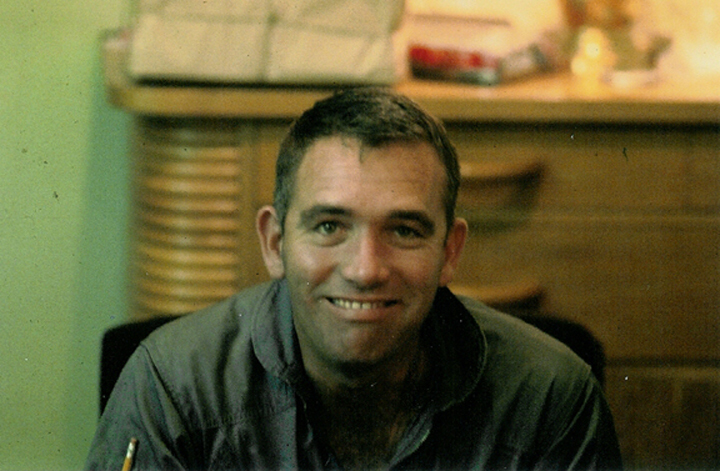 lounging around the U-2 compound when he asked to borrow some civilian clothing to go to the Officer's Club on the Base. The U-2 detachment people were not fond of that idea but said OK so long as one of their security people went along. So off they went to get a beer. They were sitting at the bar, when Murray felt a tap on the shoulder. Turning to see who did the tapping, Murray was surprised to see an old friend from the 60th Fighter Interceptor Squadron, the unit Murray came from to go to Area 51 and the Oxcart Program. The old friend asked what Murray was doing at Takhli, so Murray told him he was a Hughes Tech Rep, working on a radar in the vicinity. The friend exchanged chit chat and went his way.
lounging around the U-2 compound when he asked to borrow some civilian clothing to go to the Officer's Club on the Base. The U-2 detachment people were not fond of that idea but said OK so long as one of their security people went along. So off they went to get a beer. They were sitting at the bar, when Murray felt a tap on the shoulder. Turning to see who did the tapping, Murray was surprised to see an old friend from the 60th Fighter Interceptor Squadron, the unit Murray came from to go to Area 51 and the Oxcart Program. The old friend asked what Murray was doing at Takhli, so Murray told him he was a Hughes Tech Rep, working on a radar in the vicinity. The friend exchanged chit chat and went his way.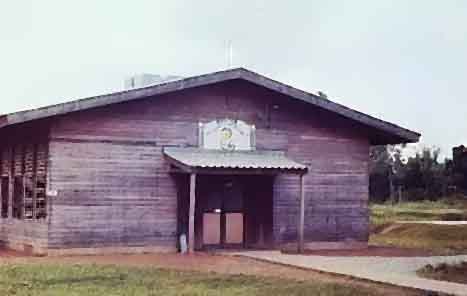 Some time later after Murray got back in the Air Force, he was sent to a refresher course on Sea Survival at Tyndall AFB in Florida. It was at this school that the old friend found Murray once again, this time as a Lt Col in the Air Force. Murray told him that he just decided to get back in the Blue Suit. The old friend said something about doubting anything Murray said, quipping that he must have been the guy that flew the Blackbird into Takhli back in '67. Murray could not confirm anything since the Program was still classified. Now one can see why the Agency guys didn't want Murray to go to the Club at Takhli.
Some time later after Murray got back in the Air Force, he was sent to a refresher course on Sea Survival at Tyndall AFB in Florida. It was at this school that the old friend found Murray once again, this time as a Lt Col in the Air Force. Murray told him that he just decided to get back in the Blue Suit. The old friend said something about doubting anything Murray said, quipping that he must have been the guy that flew the Blackbird into Takhli back in '67. Murray could not confirm anything since the Program was still classified. Now one can see why the Agency guys didn't want Murray to go to the Club at Takhli.
The second interesting event was the effect of having seen Murray and his A-12 in a combat zone. The security guys had the vice Wing Commander of the F-105 fighter squadron sign a paper where he was required to uphold the security of the Oxcart operation. This effectively ended the Colonel's combat flying in that war. Ironically, the Wing Commander Colonel was one John Giraudo. His brother Joe had been at Area 51 for some time working for the Agency as a blue suiter on Project OXCART.
This abort mission was one of a kind during the Blackshield operation, all others recovered to Kadena after overflights.
 |
 |
 |